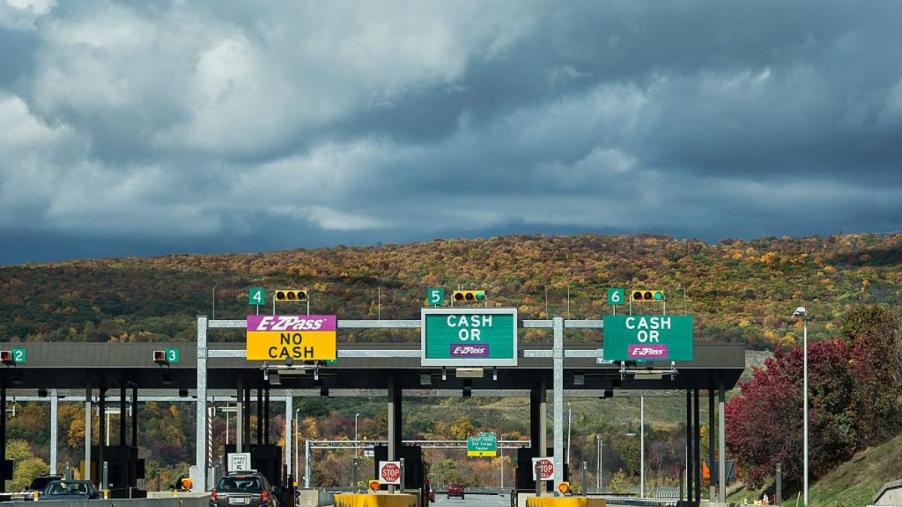
The Most Expensive Toll Road in the U.S. Would Cost Over $100 End-to-End
There are plenty of ancillary costs to driving a car around the U.S., like insurance, vehicle registration taxes, gas taxes, and, for many drivers, the convenience of using certain roads. There are more than 3,600 miles of toll roads just within the U.S. Interstate System. While some carry costs that are no more than many drivers can scrounge up from their center console, traversing some toll roads requires a hefty chunk of change.
Pennsylvania is home to the most expensive toll road
Uproad, a road toll payment service, notes the most expensive toll road in the U.S. resides in the Keystone State, and its cost is astronomical even when compared to the country’s other most expensive toll roads.
The Pennsylvania Turnpike, a 360-mile long stretch of interstate that runs east-west across Pennsylvania’s southern half, provides a thoroughfare connecting Philadelphia, Harrisburg, Pittsburgh, and points between.
Uproad notes spanning the entirety of the Pennsylvania Turnpike requires drivers to dish out $112.91. That equates to about $0.31 per mile. And that cost is for passenger cars. Large trucks can require over $200 in toll fees to traverse the entirety of the roadway.
The near-$113 cost of traveling the distance of the Turnpike is nearly quadruple that of the next most expensive toll road in the U.S. The Whiteface Mountain Memorial Highway in New York, which stops at the state’s fifth-highest peak at nearly 5,000 feet, costs just over $28.
The Ronald Reagan Turnpike in Florida costs $26.45 to traverse, while the James W. Shocknessy Ohio Turnpike ($20.50) and the Fort Bend Parkway in Texas ($0.51 per mile) are slightly less expensive to completely travel.
Uproad’s study notes the least expensive road toll in the U.S. is Boulevard Bridge in Virginia, which runs about 0.4 miles across the James River near Richmond. The toll for crossing the bridge is 35 cents.
What is the most expensive bridge toll?
The Boulevard Bridge’s 35-cent toll seems entirely reasonable against some of the priciest bridge tolls others have to pay. The Verrazano-Narrows Bridge in New York, which runs from Fort Hamilton in Brooklyn to Fort Wadsworth on Staten Island, requires $15 for a one-way trip. The bridge spans 4,260 feet, meaning drivers must pay about 35 cents per 100 feet traveled.
New York also claims the second most expensive toll bridge in the U.S. The George Washington Bridge connecting Manhattan to New Jersey over the Hudson River costs $13.75 for a one-way trip.
The Golden Gate Bridge connecting San Francisco with Marin County is iconic, and it’s also pricey at $8.60 one-way. The Tacoma Narrows Bridge in Washington earns the No. 4 most expensive one-way bridge toll in the U.S. at $6.25.
Why are tolls so expensive?
Road and bridge tolls are typically so pricey because the cost to construct and maintain highways, bridges, and roads of all types requires significant financial investment.
For instance, The FHA notes when the first segment of the Pennsylvania Turnpike opened in 1940 it was “an instant financial success.” The tolls generated enough funds to offset the bonds required to build the highway, and thus, other states began following suit.
States began establishing a toll authority to issue bonds to pay for road construction costs upfront, and after construction was completed, the bonds could be repaid with interest. Additionally, tolls generate the necessary funds to operate and maintain the stretches of road.
Even after these bonds have been paid off, a toll may continue to be levied on drivers. These revenues may generate funds for other projects by the operators of the toll road, which is typically a state authority. Though far less common in the U.S. than other parts of the world, some toll roads are operated by for-profit companies, and as their designation suggests, they will aim to make the venture as profitable as long as possible.
There are some exceptions to roads forever remaining tolled, however. The Ga. 400 extension into Atlanta was opened in 1993. After the state’s road and toll authority paid its bond debt and used funds to maintain the road, the toll was removed in 2013.



